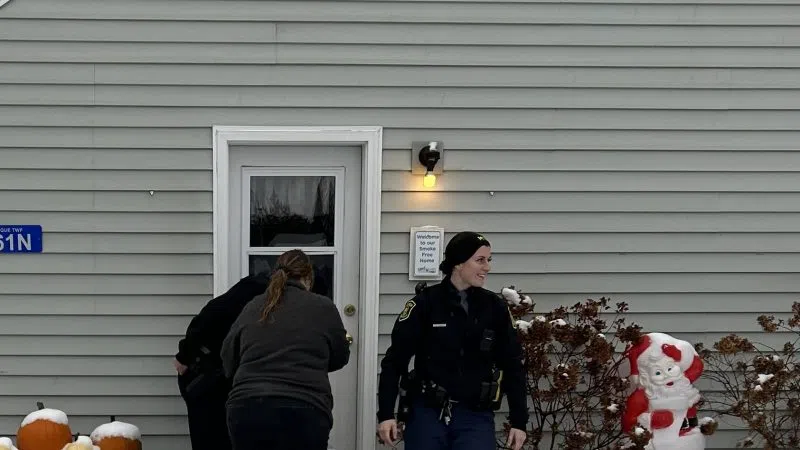Gov. Rick Snyder today proclaimed October as Fire Prevention Month to emphasize this year’s theme: “Look. Listen. Learn. Be aware. Fire can happen anywhere.” Michiganders are urged to look for places fire could start in their homes and fix any potential fire hazards; listen for the sound of the smoke alarm; and learn two ways out of every room by developing and practicing a home escape plan. State Fire Marshal Kevin Sehlmeyer kicked off Fire Prevention Month on LARA Live this morning; to view it, go to:
https://www.facebook.com/michiganLARA/videos/vb.174666982582752/995710930600085.
“We’re working to educate people about how to reduce the likelihood of having a fire in the first place, and if they do have a house fire how to escape safely,” said Sehlmeyer. “This includes identifying fire hazards and correcting them to prevent fires and knowing the importance of having working smoke alarms on each level of their home to alert families to quickly escape. Working smoke alarms provide early notification and then exiting quickly can literally make the difference between life and death in so many instances.”
Sehlmeyer explained that there’s a much smaller window of time for people to escape a home fire safely – as little as one or two minutes to escape from the time the smoke alarm sounds — largely due to more plastics and furnishing burning faster, producing large amounts of toxic gases and smoke. Knowing two ways out of every room will help people use that small window of time wisely to escape fire. Sehlmeyer also shared the importance of closing doors behind you as you exit to slow the growth of the fire.
Below are tips to make your home more fire-safe.
- Install smoke alarms on every level of the home and inside every sleeping area.
- Check the alarm by pushing the test button every month.
- Never smoke in bed. Keep lighters and cigarettes away from children.
- Never leave cooking unattended.
- Keep the stove and burners clean and free of grease while you cook to avoid the potential for a small kitchen fire that can get out of hand quickly.
- Never leave candles unattended. Place them in sturdy holders on uncluttered surfaces; keep them at least a foot away from anything that can burn . . . the curtains, bedding, furniture, carpeting.
- Have fireplaces, chimneys, and both wood and coal stoves inspected annually by a professional and cleaned if necessary.
- Never leave a fire in the fireplace unattended.
- Use caution when using space heaters. Keep space heaters at least three feet away from anything that can burn and place them on a hard-nonflammable surface, like a ceramic tile floor. Never leave them unattended.
- Replace frayed extension cords; do not overload extension cords.
- Never overload electrical outlets. Plug only one heat-producing appliance into an outlet at time.
- Major appliances should not be plugged in using extension cords and plug strips. Plug appliances directly into the wall receptacle.
- Keep clothes and other items three feet away for your gas water heater that can ignite items when the water heater comes on.
- Clean the dryer lint screen after each load as lint is extremely flammable.
- Have a fire extinguisher in the home and know how to use it.
- Develop and practice a home fire escape plan that the entire family knows that includes two ways out of every room.
- Make sure all doors and windows leading outside open easily and are free of clutter.
- Sleep with bedroom doors closed to limit fire spread. Closing the door before dozing can save lives by reducing toxic smoke levels and slowing down the spread of fire and smoke into sleeping areas.
- Make sure you close doors behind you as you escape a fire.
“Fire can happen to you,” Sehlmeyer emphasized. “With a few practical and essential preventive measures, people can eliminate fire hazards in their home, and be better prepared to expect the unexpected if a fire occurs in their home.”
For the last several years, Michigan has ranked in the top tier of states nationally for its high number of residential fire fatalities. In the first nine months of this year alone, Michigan’s home fire death total has already reached 90 percent of the total fire deaths recorded during all of 2017. From January 1 through September 28, 2018, there have been 87 residential fire deaths in 66 residential fires reported by the fire service.
Sehlmeyer said smoking is the number one cause of home fire fatalities in Michigan, with the majority of victims over age 40; that is, 43 percent (37 deaths) of residents age 40-69, with an additional 16 percent (17 deaths) age 70 and over who have perished in home fires during the first nine months of 2018. We ask families to visit and check the smoke alarms for their elderly family members, by “pushing the button” to test each smoke alarms.
The Michigan Community Risk Reduction (CRR) Task Force, made up of more than 70 volunteers, are coordaining a statewide effort to reduce fire fatalities in urban, suburban, and rural communities across the state. For more information go to: Michigan CRR 2018-2020 Strategic Plan. The CRR Task Force is comprised of members from fire departments across the state, the Bureau of Fire Services staff, representatives from Michigan Fire Service organizations, the Michigan Fire Inspectors Society, and the American Red Cross-Michigan Chapter, and has support of the National Fire Protection Association (NFPA).
The Michigan Bureau of Fire Services joins the NFPA and other state and national organizations in recognizing Fire Prevention week and is extending educational outreach efforts to fire departments and the public during the entire month of October. The NFPA has been the official sponsor of Fire Prevention Week for more than 90 years making it the longest-running public health and safety observance on record. For more information about preventing fires and staying safe, go to the NFPA official Fire Prevention Week website atwww.firepreventionweek.org.
For more information about fire safety go to the Bureau of Fire Services website at www.michigan.gov/bfs























